 Born in the popular contexts of the 1800s Lisbon, Fado was present in convivial and leisure moments. Happening spontaneously, its execution took place indoors or outdoors, in gardens, bullfights, retreats, streets and alley, taverns, cafés de camareiras and casas de meia-porta. Evoking urban emergence themes, singing the daily narratives, Fado is profoundly related to social contexts ruled by marginality and transgression in a first phase, taking place in locations visited by prostitutes, faias, sailors, coachmen and marialvas. Often surprised in prison, its actors - the singers - are described in the faia figure, a fado singer guy, a bully of a rough and hoarse voice with tattoos and skilled with a flick knife who spoke using slang. As we will see, fado’s association to society’s most marginal spheres would definitely make the Portuguese intellectuals reject it profoundly.
Born in the popular contexts of the 1800s Lisbon, Fado was present in convivial and leisure moments. Happening spontaneously, its execution took place indoors or outdoors, in gardens, bullfights, retreats, streets and alley, taverns, cafés de camareiras and casas de meia-porta. Evoking urban emergence themes, singing the daily narratives, Fado is profoundly related to social contexts ruled by marginality and transgression in a first phase, taking place in locations visited by prostitutes, faias, sailors, coachmen and marialvas. Often surprised in prison, its actors - the singers - are described in the faia figure, a fado singer guy, a bully of a rough and hoarse voice with tattoos and skilled with a flick knife who spoke using slang. As we will see, fado’s association to society’s most marginal spheres would definitely make the Portuguese intellectuals reject it profoundly.
Stating the communion of ludic spaces between the bohemian aristocracy and the most disfavoured fringes of Lisbon’s population, the history of fado crystallized into myth the episode of the amorous relationship between the Count Vimioso and Maria Severa Onofriana (1820-1846), a prostitute consecrated by her singing talents, who would soon transform into one of greatest myths of the History of Fado. In successive image and sound reprises, the allusion to the involvement between a bohemian aristocrat with the fado singing prostitute would cross several sung poems and even the cinema and the theatre or the visual arts - beginning with the novel A Severa, by Júlio Dantas, published in 1901 and transported to the silver screen in 1931 - the first Portuguese sound film, directed by Leitão de Barros.
Fado would also conquer ground in festive events connected to the citys popular calendar, beneficence parties or cegadas - amateur and popular theatrical presentations generally performed by men on the street, in night feats, and popular associations. Although this sort of presentation was a famous entertaining form of Lisbon’s Carnival, enjoying popular support and often with strong intervening characters, the censorship regulation in 1927 would strongly but irreversibly contribute to the extinction of this type of show.
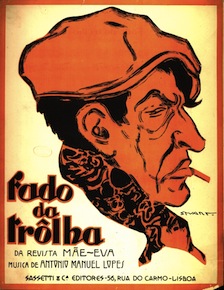 The Teatro de Revista [a sort of vaudeville theatre], a typical theatre genre from Lisbon born in 1851, would soon discover fado’s potential. In 1870, fado began to appear in its music scenes and from there projects itself to a broader audience. Lisbon’s social e cultural context, with its typical neighbourhoods, and bohemia, assumed an absolute protagonism in Teatro de Revista. Ascending to the theatre stages, fado would animate the Revista, developing new themes and melodies. Teatro de Revista was orchestrated and filled with refrains. Fado would be sung by famous actresses, and renowned fado singers, singing their repertoires. Two different approaches to fado would become recorded in history: the danced fado stylized by Francis and the spoken fado of João Villaret. A central figure in the history of Fado, Hermínia Silva conquered fame on the theatre stages in the 1930s and 1940s, adding her unmistakable singing gifts to those of a comical actress and revisteira.
The Teatro de Revista [a sort of vaudeville theatre], a typical theatre genre from Lisbon born in 1851, would soon discover fado’s potential. In 1870, fado began to appear in its music scenes and from there projects itself to a broader audience. Lisbon’s social e cultural context, with its typical neighbourhoods, and bohemia, assumed an absolute protagonism in Teatro de Revista. Ascending to the theatre stages, fado would animate the Revista, developing new themes and melodies. Teatro de Revista was orchestrated and filled with refrains. Fado would be sung by famous actresses, and renowned fado singers, singing their repertoires. Two different approaches to fado would become recorded in history: the danced fado stylized by Francis and the spoken fado of João Villaret. A central figure in the history of Fado, Hermínia Silva conquered fame on the theatre stages in the 1930s and 1940s, adding her unmistakable singing gifts to those of a comical actress and revisteira.Fado’s appropriation field broadened in the last quarter of the 19th century. This was the time of the formal stabilization of the poetic form of the “ten-verse stanza”, a quatrain made of four stanzas of ten verses each, on which fado would get its structure and later develop into other variants. This is also the period of the definition of the Portuguese guitar - progressively diffused from the urban centres to the country’s rural areas - in its specific component as fado companion.
In the first decades of the 20th century, fado began to be gradually divulged and gained popular consecration through the publication of periodicals on the subject and the consolidation of new performing venues in a broad network that began incorporating Fado in its agenda with a commercial perspective, fixating private casts which would often form embassies or artistic groups for tours. In parallel the relationship of Fado with the theatre stages was consolidated and the performances by fado singers at Revistas musical scenes and operettas multiplied.
In fact, the appearance of fado singing professional companies in the 1930s allowed promoting shows with great casts and their circulation in theatres north and south of the country, and even in international tours. That was the case of “Grupo Artístico de Fados”, with Berta Cardoso (1911-1997), Madalena de Melo (1903-1970), Armando Augusto Freire, (1891-1946) Martinho d’Assunção (1914-1992) and João da Mata, and “Grupo Artístico Propaganda do Fado”, with Deonilde Gouveia (1900-1946), Júlio Proença (1901-1970) and Joaquim Campos (1899-1978), or “Troupe Guitarra de Portugal”, with Ercília Costa (1902-1985) and Alfredo Marceneiro (1891-1982) among others.
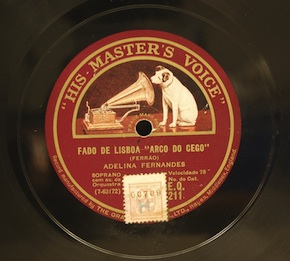 Although the first discographic records produced in Portugal date from the beginning of the 20th century, at this stage the national market was still very incipient since it was quite expensive to buy gramophones and records. Effectively, the fundamental conditions for recording sound appeared after the invention of the electric microphone in 1925. At the same time, gramophones started being made at more competitive prices. And thus were created more favourable conditions to this market among the middle class.
Although the first discographic records produced in Portugal date from the beginning of the 20th century, at this stage the national market was still very incipient since it was quite expensive to buy gramophones and records. Effectively, the fundamental conditions for recording sound appeared after the invention of the electric microphone in 1925. At the same time, gramophones started being made at more competitive prices. And thus were created more favourable conditions to this market among the middle class.In the context of the mediatization instruments of Fado, TSF - wireless telegraphy - had a central importance in the first decades of the 20th century. Among the intense activity of radio broadcasting stations between 1925 and 1935, we highlight CT1AA, Rádio Clube Português, Rádio Graça and Rádio Luso - this last one quickly becoming popular for favouring fado. The broadcasts of the first Portuguese radio station, CT1AA, began in 1925. Investing on technical and logistic infrastructures which guaranteed it the expansion of its broadcast range and the broadcasts regularity, CT1AA of Abílio Nunes incorporated fado in its broadcasts, conquering a large group of listeners, including in the Portuguese emigration diaspora. With live feeds from the Theatres and musical live presentations at the studios, CT1AA also promoted the broadcast of an experimental fado show directed by the Spanish guitar player Amadeu Ramin.
With the military coup of the 28 May 1926 and the implementation of previous censorship on public shows, the press and other publications, the urban song would suffer profound changes. In fact, in the following year the Decree Law Number 13 564 of 6 May 1927 globally regulated the show activities through extensive clauses; defending a “superior supervision of all the houses and show venues or public entertaining (...) by the General Inspection of Theatres and its delegates in behalf of the Public Instruction Ministry” on its 200 articles. Fado suffered unavoidable changes. The legal instrument regulated on the attribution of licenses to the companies which promoted shows at the most diversified venues, authorship rights, mandatory previous viewing of shows and sung repertoires, specific regulation for attributing the professional card, contracts, and tour travelling, among many other subjects. Significant mutations were so imposed on the performing venues, on the way interpreters presented themselves, and on the sung repertoires - striped of any improvised character - cementing a professionalization process of several interpreters, instrument players, song writers and composers, who were then performing at several venues before an increasing audience.
The hearing of fados would gradually become ritualized at fado houses, places which concentrated in the city’s historic neighbourhoods, mainly in Bairro Alto, especially since the 1930s. These transformations in the fado production would necessarily drift it apart from improvise, loosing some of its original performing contexts diversity and imposing the specialization of interpreters, authors and musicians. In parallel, the discographic and radio recordings proposed a triage of voices and performing practices that were imposed as models, thus limiting improvise.
The next decade, the revivalism trends of the so called typical features would definitely prevail, leading to a replication of the most genuine and picturesque in fado’s performing venues.
Fado was present in the theatre and the radio since their first moments and the same would happen in the Seventh Art. In fact, the appearance of sound films was marked by the musical genre and the Portuguese cinema gave special attention to fado. Proving it, the theme of the first Portuguese sound film, directed by Leitão de Barros in 1931, was the misfortunes of the mythical Severa. As a central theme or a mere side note, fado accompanied cinema production until the 1970s. In fact, the Portuguese cinema showed particular interest in the fado universe in 1947 with O Fado, História de uma Cantadeira, starred by Amália Rodrigues or in 1963, with O Miúdo da Bica, starred by Fernando Farinha. Despite the protagonism of Amália Rodrigues, the participations of artists like Fernando Farinha, Hermínia Silva, Berta Cardoso, Deolinda Rodrigues, Raul Nery and Jaime Santos in the Seventh Art are also noteworthy.
And if radio broadcasting allowed to go beyond geographical barriers, taking the voices of fado to thousands of people, when Rádio Televisão Portuguesa was inaugurated in 1957 – and specially when the broadcast became national in the mid-1970s - the faces of the artists would become known by the general public. Recreating environments connected to fado themes inside the study, television broadcasted regularly, between 1959 and 1974, with live feeds of fado shows which would undoubtedly contribute to its mediatization.
Enjoying the diffusion on the Teatro de Revista stages since the last quart of the 19th century, and the promotion on the specialized press since the first decades of the 20th century, Fado became progressively mediatized by the radio, cinema, and television. It gained great strength between the 1940s and 1960, often called the golden years.. The annual contest Grande Noite do Fado began in 1953, lasting until our days. Gathering hundreds of candidates from several organizations and associations of the city, this contest is traditionally held at Coliseu dos Recreios and is still today an important event to the fado tradition of Lisbon and the promotion of young amateurs who try to rise to the professional status.
The exponents of the national song were at the time attached to a network of typical houses with regular casts. But now they had a broader working market with many possibilities of discographic recording, tours, performances at radio and television. In parallel, there were performances by fado singers at “Serões para Trabalhadores”, cultural events broadcast by the radio and promoted by FNAT since 1942. Fado programmes were also promoted by the Secretariado Nacional de Informação, Cultura e Turismo which became responsible for the Censhorship, Emissora Nacional, and Inspecção Geral dos Espectáculos in 1944. In the 1950s, the regime’s approach to the international success of Amália Rodrigues strengthened the collage of the regime to fado, after changing it deeply.
The simplicity of Fado’s melodic structure values the voice interpretation, and also sublimes the sung repertoires. With a strong evocative inclination, fado’s poetry appeals to the communion between the interpreter, the musicians and the listeners. In quatrains or improvised quatrains, five-verse stanzas, six-verse stanzas, decasyllables and alexandrine verses, this popular poetry evokes themes related to love, luck, individual fate, and the city’s daily narrative. Sensitive to social injustice, Fado gained interventionist contours on many occasions.
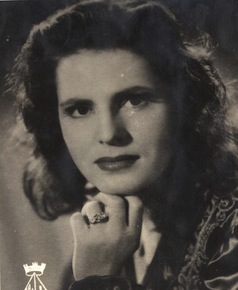 And although the first Fado lyrics were mostly anonymous, successively transmitted by oral tradition, this would definitely be reverted in the mid-1920s, when several popular poets emerged, such as Henrique Rego, João da Mata, Gabriel de Oliveira, Frederico de Brito, Carlos Conde and João Linhares Barbosa, who gave special attention to fado. In the 1950s, fado would definitely cross the path of erudite poetry in the voice of Amália Rodrigues. After the decisive contribution of the composer Alain Oulman, fado began singing texts of poets with academic education and published literary works, such as David Mourão-Ferreira, Pedro Homem de Mello, José Régio, Luiz de Macedo, and later Alexandre O.Neill, Sidónio Muralha, Leonel Neves and Vasco de Lima Couto, among many others.
And although the first Fado lyrics were mostly anonymous, successively transmitted by oral tradition, this would definitely be reverted in the mid-1920s, when several popular poets emerged, such as Henrique Rego, João da Mata, Gabriel de Oliveira, Frederico de Brito, Carlos Conde and João Linhares Barbosa, who gave special attention to fado. In the 1950s, fado would definitely cross the path of erudite poetry in the voice of Amália Rodrigues. After the decisive contribution of the composer Alain Oulman, fado began singing texts of poets with academic education and published literary works, such as David Mourão-Ferreira, Pedro Homem de Mello, José Régio, Luiz de Macedo, and later Alexandre O.Neill, Sidónio Muralha, Leonel Neves and Vasco de Lima Couto, among many others.The international divulgation of Fado had begun in the mid-1930s. Fado spread towards the African continent and Brazil, preferred performing destinations of some artists such as Ercília Costa, Berta Cardoso, Madalena de Melo, Armando Augusto Freire, Martinho d’Assunção and João da Mata, among others. However, the internationalization of fado would only consolidate in the 1950s, especially thanks to Amália Rodrigues.
Surpassing the cultural and language barriers, Fado would definitely become a national culture icon with Amália. For decades and until her death, in 1999, Amália Rodrigues was its national and international star.
The April 1974 Revolution instituted a democratic State in Portugal, founded on the assumption of the integration of public liberties, respect and guaranty of individual rights with the inherent opening of a more active civic, political and social participation to citizens. As a result of the global society, the mass culture influences would be felt progressively over the following decades. This context modified fado’s relation with the Portuguese market, centred on popular music with an intervening character while simultaneously absorbing many of the musical forms created abroad.
In the years immediately after the revolution, the two years’ interruption of the contest Grande Noite do Fado and the radical decrease of fado’s presence at radio or television broadcasts testify the hostility towards fado.
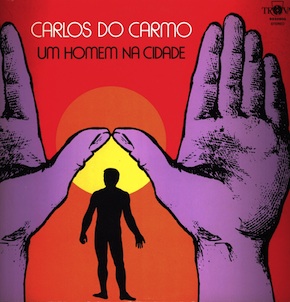 In fact, only when the democratic regime became stable, in 1976, would fado regain its own space. The following year the album Um Homem na Cidade was released by one of the biggest names of Lisbon’s urban song, a central figure of fado’s internationalization. As no other, the owner of a solid 45 years career has articulated the most legitimate fado tradition to an unending ability to recreate it.
In fact, only when the democratic regime became stable, in 1976, would fado regain its own space. The following year the album Um Homem na Cidade was released by one of the biggest names of Lisbon’s urban song, a central figure of fado’s internationalization. As no other, the owner of a solid 45 years career has articulated the most legitimate fado tradition to an unending ability to recreate it.As the ideological debate around fado gradually comes to an end, it was mostly since the 1980s that fado consenso is recognized its central position in the scene of the Portuguese musical patrimony. The market showed a renewed interest for Lisbon.s urban song, as testified by the increasing attention given by the discographic industry through the re-edition of recorded registries, fado.s gradual interpretation in the popular festivities circuits at a regional scale, the progressive appearance of a new generation of interpreters, and even the approach of singers from other areas to fado such as José Mário Branco, Sérgio Godinho, António Variações and Paulo de Carvalho.
Internationally there is also a renewed interest in local musical cultures. Amália Rodrigues and Carlos do Carmo are notorious among fado most famous names in the record industry, the media and live shows.
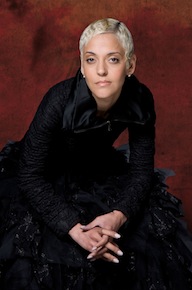 In the 1990s, fado would definitely cement its position in the international World Music circuits with Mísia and Cristina Branco, in the French and the Dutch circuits, respectively. Another emerging name in Fado.s panorama is Camané. In the 1990s and the turn of the century a new generation of talented interpreters appears: Mafalda Arnauth, Katia Guerreiro, Maria Ana Bobone, Joana Amendoeira, Ana Moura, Ana Sofia Varela, Pedro Moutinho, Helder Moutinho, Gonçalo Salgueiro, António Zambujo, Miguel Capucho, Rodrigo Costa Félix, Patrícia Rodrigues, and Raquel Tavares. In the international circuit, however, it is Mariza who conquers an absolute protagonism, drawing a fulgurant pathway during which she has won successive prizes in the World Music category.
In the 1990s, fado would definitely cement its position in the international World Music circuits with Mísia and Cristina Branco, in the French and the Dutch circuits, respectively. Another emerging name in Fado.s panorama is Camané. In the 1990s and the turn of the century a new generation of talented interpreters appears: Mafalda Arnauth, Katia Guerreiro, Maria Ana Bobone, Joana Amendoeira, Ana Moura, Ana Sofia Varela, Pedro Moutinho, Helder Moutinho, Gonçalo Salgueiro, António Zambujo, Miguel Capucho, Rodrigo Costa Félix, Patrícia Rodrigues, and Raquel Tavares. In the international circuit, however, it is Mariza who conquers an absolute protagonism, drawing a fulgurant pathway during which she has won successive prizes in the World Music category.Excertos do texto:
Pereira, Sara (2008), “Circuito Museológico”, in Museu do Fado, Lisboa: EGEAC/Museu do Fado.